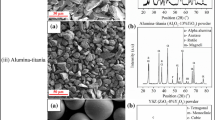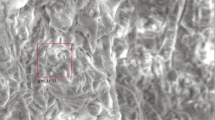Abstract
Alumina coatings are prepared by atmospheric plasma spraying through controlling the substrate temperature during spraying. The changes in microstructure and mechanical properties of the coatings prepared at different substrate temperatures are examined. The hardness and the elastic modulus of the coatings are measured by indentation methods. The results show that interlamellar bonding in the coatings is significantly improved with increasing the substrate temperature. Moreover, long through-thickness columnar grains form in the coatings when the substrate temperature reaches above 430°C. As a result, the cross-sectional hardness and the elastic modulus perpendicular to the coating surface increase with increasing the substrate temperature.
Similar content being viewed by others
References
McPherson, R., A review of microstructure and properties of plasma sprayed ceramic coatings. Surface and Coatings Technology, 1989, 39–40: 173–181.
Li, C.J. and Ohmori, A., Relationships between the microstructure and properties of thermally sprayed coatings. Journal of Thermal Spray Technology, 2002, 11: 365–374.
Ohmori, A. and Li, C.J., Quantitative characterization of the structure of plasma sprayed Al2O3 coating by using copper electroplating. Thin Solid Films, 1991, 201: 241–252.
Xing, Y.Z., Li, C.J., Li, C.X. and Yang, G.J., Influence of through-lamella grain growth on ionic conductivity of plasma-sprayed yttria-stabilized zirconia as an electrolyte in solid oxide fuel cells. Journal of Power Sources, 2008, 176: 31–38.
Xing, Y.Z., Li, C.J., Zhang, Q., Li, C.X. and Yang, G.J., Influence of microstructure on the ionic conductivity of plasma-sprayed yttria-stabilized zirconia deposits. Journal of the American Ceramic Society, 2008, 91: 3931–3936.
Tricoire, A., Vardelle, M., Fauchais, P., Braillard, F., Malié, A. and Bengtsson, P., Macrocrack formation in plasma-sprayed YSZ TBCs when spraying thick passes. High Temperature Material Processes, 2005, 9: 401–413.
Jung, I.H., Bae, K.K., Yang, M.S. and Ihm, S.K., A study of the microstructur of yttria-stabilized zirconia deposited by inductively coupled plasma spraying. Journal of Thermal Spray Technology, 2000, 9: 463–477.
Jung, I.H., Moon, J.S., Song, K.C. and Yang, M.S., Microstructure of yttria stabilized zirconia deposited by plasma spraying. Surface and Coatings Technology, 2004, 180–181: 454–457.
Guo, H.B., Vaβen, R. and Stöver, D., Atmospheric plasma sprayed thick thermal barrier coatings with high segmentation crack density. Surface and Coatings Technology, 2004, 186: 353–363.
Guo, H.B., Kuroda, S. and Murakami, H., Microstructures and properties of plasma-spayed segmented thermal barrier coatings. Journal of the American Ceramic Society, 2006, 89: 1432–1439.
Heintze, G.N. and Uematsu, S., Preparation and structures of plasma-sprayed γ- and α-Al2O3 coatings. Surface and Coatings Technology, 1992, 50: 213–222.
Marshall, D.B., Noma, T. and Evans, A.G., A simple method for determining elastic-modulus-to-hardness ratios using knoop indentation measurements. Journal of the American Ceramic Society, 1982, 65: C175–C176.
Li, M., Hu, W., Sun, X., Guan, H. and Hu, Z., Study on elastic modulus and fracture toughness of an EB-PVD thermal barrier coatings. Rare Metal Materials and Engineering, 2006, 35: 577–580(in Chinese).
Liu, J. and Ding, C., Determining microhardness and elastic modulus of plasma-sprayed Cr3C2-NiCr coatings using Knoop indentation testing. Surface and Coatings Technology, 2001, 135: 229–237.
Bocanegra-Bernal, M.H., Domínguez-Rios, C., Garcia-Reyes, A., Aguilar-Elguezabal, A., Echeberria, J. and Nevarez-Rascon, A., Fracture toughness of an α-Al2O3 ceramic for joint prostheses under sinter and sinter-HIP conditions. International Journal of Refractory Metals & Hard Materials, 2009, 27: 722–728.
Li, C.J., Ohmori, A. and McPherson, R., The relationship between microstructure and Young’s modulus of thermally sprayed ceramic coatings. Journal of Materials Science, 1997, 32: 997–1004.
Hao, S., Li, C.J. and Yang, G.J., Influence of deposition temperature on the microstructures and properties of plasma-sprayed Al2O3 coatings. Journal of Thermal Spray Technology, 2011, 20: 160–169.
Author information
Authors and Affiliations
Corresponding author
Additional information
Project supported by the Special Fund for Basic Scientific Research of Central Colleges, Chang’an University, and the Special Fund for Basic Research Support Program of Chang’an University (grant No. CHD2009JC131).
Rights and permissions
About this article
Cite this article
Xing, Y., Jiang, C., Chen, H. et al. Microstructure and Mechanical Properties of Alumina Coatings Plasma-Sprayed at Different Substrate Temperatures. Acta Mech. Solida Sin. 24, 461–466 (2011). https://doi.org/10.1016/S0894-9166(11)60045-1
Received:
Revised:
Published:
Issue Date:
DOI: https://doi.org/10.1016/S0894-9166(11)60045-1




